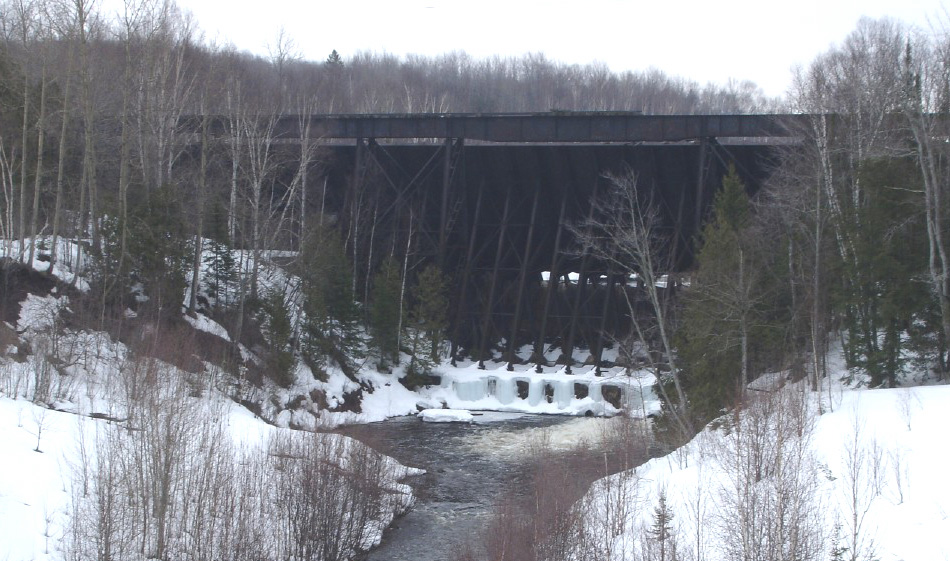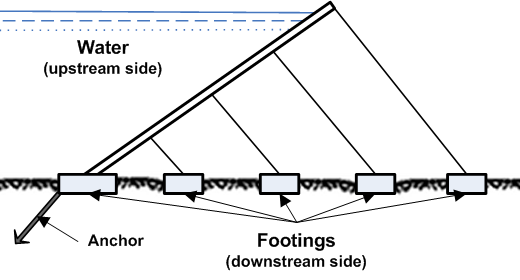Steel dam on:
[Wikipedia]
[Google]
[Amazon]
 A steel dam is a type of
A steel dam is a type of
 Steel dams use a series of footings anchored in the earth. These footings hold struts which in turn hold up a series of deck girders which in turn hold steel plates. It is these plates that the water comes in contact with. The girders and plates are angled in the downstream direction so that part of the weight of the water acts with a downward force on the struts and footings, holding them in place. If the plates were vertical, as in a steel
Steel dams use a series of footings anchored in the earth. These footings hold struts which in turn hold up a series of deck girders which in turn hold steel plates. It is these plates that the water comes in contact with. The girders and plates are angled in the downstream direction so that part of the weight of the water acts with a downward force on the struts and footings, holding them in place. If the plates were vertical, as in a steel
 In the direct strutted version, shown in the illustration at left, all the struts are parallel. There is thus no tensile force in the plate girders.
In the direct strutted version, shown in the illustration at left, all the struts are parallel. There is thus no tensile force in the plate girders.
 In the cantilever strutted version, shown in the illustration at left, the top strut (or struts, depending on design) can be fashioned into a
In the cantilever strutted version, shown in the illustration at left, the top strut (or struts, depending on design) can be fashioned into a
Irrigation and Water Power Engineering
a book found via Google books. One of few sources to mention steel dams, says there are 3 extant in the US and gives some info. Some of this article uses material from this text.
A Brief History of Steel Dams by Hubert CHANSON (you will have to press the PROCEED button to carry on to the article after following the link). It indicates that the Hauser Lake dam was built between 1905-1907 and failed in 1908, after SCHUYLER (1909).
 A steel dam is a type of
A steel dam is a type of dam
A dam is a barrier that stops or restricts the flow of surface water or underground streams. Reservoirs created by dams not only suppress floods but also provide water for activities such as irrigation, human consumption, industrial use ...
(a structure to impound or retard the flow of water) that is made of steel, rather than the more common masonry
Masonry is the building of structures from individual units, which are often laid in and bound together by mortar; the term ''masonry'' can also refer to the units themselves. The common materials of masonry construction are bricks, building ...
, earthworks, concrete
Concrete is a composite material composed of fine and coarse aggregate bonded together with a fluid cement (cement paste) that hardens (cures) over time. Concrete is the second-most-used substance in the world after water, and is the most wid ...
or timber
Lumber is wood that has been processed into dimensional lumber, including beams and planks or boards, a stage in the process of wood production. Lumber is mainly used for construction framing, as well as finishing (floors, wall panels, w ...
construction materials.
Relatively few examples were ever built. Of the three built in the US, two remain: the Ashfork-Bainbridge Steel Dam, built in 1898 in the Arizona desert to supply locomotive water to the Atchison, Topeka and Santa Fe Railway
The Atchison, Topeka and Santa Fe Railway , often referred to as the Santa Fe or AT&SF, was one of the larger railroads in the United States. The railroad was chartered in February 1859 to serve the cities of Atchison, Kansas, Atchison and Top ...
(ATSF), and the Redridge Steel Dam
The Redridge Steel Dam is a steel dam across the Salmon Trout River in Redridge, Houghton County, Michigan. Completed in 1901, it is a flat slab buttress dam constructed of steel, a relatively rare material for construction of dams, which are typ ...
, built 1901, in the Upper Peninsula of Michigan
The Upper Peninsula of Michigan – also known as Upper Michigan or colloquially the U.P. – is the northern and more elevated of the two major landmasses that make up the U.S. state of Michigan; it is separated from the Lower Peninsula by ...
to supply water to stamp mills. The third, the Hauser Lake Dam in Montana, was finished in 1907 but failed in 1908.
Steel dams were found to be uneconomical after World War I
World War I (28 July 1914 11 November 1918), often abbreviated as WWI, was one of the deadliest global conflicts in history. Belligerents included much of Europe, the Russian Empire, the United States, and the Ottoman Empire, with fightin ...
, as the price of steel increased by many multiples, compared with cement prices. Their economics are highly favourable in 21st century due to lower total onsite labour costs, lower cost for bulk material transportation, availability of more construction time in a year, and flexibility in construction plan complying statuary requirements, etc.
Principles of operation
 Steel dams use a series of footings anchored in the earth. These footings hold struts which in turn hold up a series of deck girders which in turn hold steel plates. It is these plates that the water comes in contact with. The girders and plates are angled in the downstream direction so that part of the weight of the water acts with a downward force on the struts and footings, holding them in place. If the plates were vertical, as in a steel
Steel dams use a series of footings anchored in the earth. These footings hold struts which in turn hold up a series of deck girders which in turn hold steel plates. It is these plates that the water comes in contact with. The girders and plates are angled in the downstream direction so that part of the weight of the water acts with a downward force on the struts and footings, holding them in place. If the plates were vertical, as in a steel cofferdam
A cofferdam is an enclosure built within a body of water to allow the enclosed area to be pumped out. This pumping creates a dry working environment so that the work can be carried out safely. Cofferdams are commonly used for construction or re ...
, all the force would be horizontal and much more massive struts and anchors would be required to counteract the horizontal force and bending moment.
Direct strutted
 In the direct strutted version, shown in the illustration at left, all the struts are parallel. There is thus no tensile force in the plate girders.
In the direct strutted version, shown in the illustration at left, all the struts are parallel. There is thus no tensile force in the plate girders.
Cantilever strutted
 In the cantilever strutted version, shown in the illustration at left, the top strut (or struts, depending on design) can be fashioned into a
In the cantilever strutted version, shown in the illustration at left, the top strut (or struts, depending on design) can be fashioned into a cantilever
A cantilever is a rigid structural element that extends horizontally and is supported at only one end. Typically it extends from a flat vertical surface such as a wall, to which it must be firmly attached. Like other structural elements, a cant ...
truss. By all going to the same footing, the upper part of the deck girders are thus in tension and the moment of the cantilever section is offset by the moment of the water impinging on that section.
Scalloping
In both types of construction, it is typical for the plates to have a scalloped appearance, as can be seen in theRedridge Steel Dam
The Redridge Steel Dam is a steel dam across the Salmon Trout River in Redridge, Houghton County, Michigan. Completed in 1901, it is a flat slab buttress dam constructed of steel, a relatively rare material for construction of dams, which are typ ...
illustration, above. It is to allow free expansion/contraction of the steel plates as the water or ambient temperature changes.
Design tradeoffs
There are two design trade-offs, the girder plate angle and the strut angle. Increasing the girder/plate angle towards the horizontal, the normal component of the force will increase towards vertical; this means that footings do not need to resist as much horizontal force, but requires more steel for a given upstream head. Increasing the strut angle towards vertical reduces the horizontal moment on the footings, reducing the risk of sliding.Spillways and pipes
Steel dams may or may not have a spillway. The Ashfork-Bainbridge did not have one but was designed to allow water to pour directly over the crest, while the Redridge had both a spillway and awater pipe
Plumbing is any system that conveys fluids for a wide range of applications. Plumbing uses pipes, valves, plumbing fixtures, tanks, and other apparatuses to convey fluids. Heating and cooling (HVAC), waste removal, and potable water delive ...
to supply water to downstream stamp mills.
Advantages and disadvantages
Steel Dam proponents claimed some advantages: *Steel fabrication techniques, even at the turn of the 19th century, allowed for faster and cheaper construction than masonry *The structure is statically determinate allowing precise calculations of load and member strength needed *Since steel is more flexible than concrete, they are more resistant to catastrophic failure due to ground settling *Frost does not affect them the way it does concrete or masonry *Non–catastrophic leaks can be addressed by welding There were also some known disadvantages: *Constructing good footings is key to a successful dam as they must bear weight, not settle too much and resist horizontal travel. *The long term strength of the dam is not known. The two examples in the US still standing are not currently under significant water load *The lightness of the structure means it is more vulnerable to wear due to water vibrations than more massive dams *Maintenance needs are higher, rust and corrosion must be addressed *Stresses can be quite concentrated, which could cause stress cracking as a failure mode. *As with other dams, undermining is a possible failure mode (this is believed to be why the Hauser Lake dam failed.)Further reading
* Jackson, Donald C. Great American Bridges and Dams, John Wiley & Sons, New York (USA), , 1984; pp. 210–211.Irrigation and Water Power Engineering
a book found via Google books. One of few sources to mention steel dams, says there are 3 extant in the US and gives some info. Some of this article uses material from this text.
A Brief History of Steel Dams by Hubert CHANSON (you will have to press the PROCEED button to carry on to the article after following the link). It indicates that the Hauser Lake dam was built between 1905-1907 and failed in 1908, after SCHUYLER (1909).
References
{{Reflist Dams by type